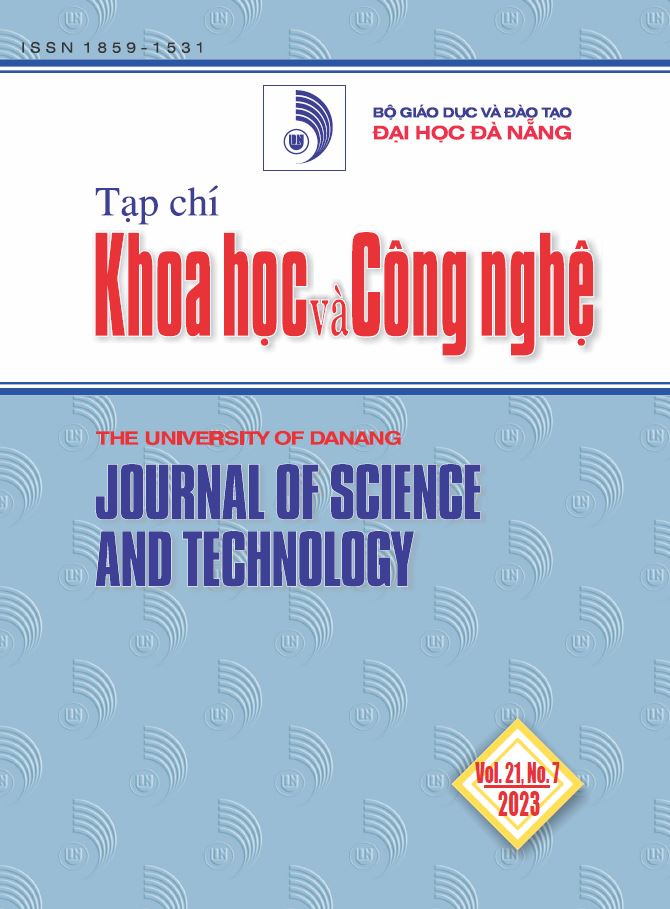Nghiên cứu tính chất phát quang của ion đất hiếm Ce3+ trong thủy tinh aluminoborate
 Tóm tắt: 314
Tóm tắt: 314
 |
|  PDF: 184
PDF: 184 
##plugins.themes.academic_pro.article.main##
Author
-
Trịnh Ngọc ĐạtTrường Đại học Sư phạm - Đại học Đà Nẵng, Đà Nẵng, Việt NamPhan LiễnTrường Đại học Sư phạm - Đại học Đà Nẵng, Đà Nẵng, Việt NamLê Văn Thanh SơnTrường Đại học Sư phạm - Đại học Đà Nẵng, Đà Nẵng, Việt NamLê Vũ Trường SơnTrường Đại học Sư phạm - Đại học Đà Nẵng, Đà Nẵng, Việt NamMai Thị Kiều LiênTrường Đại học Sư phạm - Đại học Đà Nẵng, Đà Nẵng, Việt Nam
Từ khóa:
Tóm tắt
Vật liệu thủy tinh oxit với thành phần Na2O:Al2O3:BaO:B2O3 (NABB) pha tạp ion Ce3+ với các nồng độ từ 0,1% đến 2,5% được tổng hợp bằng phương pháp nóng chảy. Tính chất cấu trúc của vật liệu được nghiên cứu bằng các phép đo nhiễu xạ tia X (XRD) và phổ Raman. Tính chất phát quang cũng được phân tích dựa trên phổ kích thích và phổ phát quang. Giản đồ nhiễu xạ tia X chứng tỏ rằng vật liệu chế tạo được có cấu trúc vô định hình trong khi đó phổ Raman chỉ ra được các dao động của các liên két trong mạng thủy tinh. Phổ quang phát quang cho thấy, ảnh hưởng của sự thay đổi nồng độ Ce3+ đến sự phát quang của vật liệu. Trong nền NABB bước sóng phù hợp để kích thích các mẫu là 302nm, phổ phát quang của ion Ce3+ trong vùng tử ngoại có bước sóng 352 – 362 nm ứng với chuyển dời 5d à 4f của ion Ce3+ cho thấy, có khả năng ứng dụng để sản xuất LED màu xanh dương ứng dụng trong nông nghiệp hoặc sử dụng trong các thiết bị quang tử.
Tài liệu tham khảo
-
[1] S. M. Alajerami et al., "Optical properties of lithium magnesium borate glasses doped with Dy3+ and Sm3+ ions”, Physica B: Condensed Matter, vol. 407, no. 13, pp. 2398-2403, 2012.
[2] Feng et al., "Optical properties and upconversion in rare earth doped oxyfluoride glasses”, Optik, vol. 169, pp. 118-124, 2018.
[3] V. K. Reddy et al., "Enhancement of the red emission of Eu3+ by Bi3+ sensitizers in yttrium alumino bismuth borosilicate glasses”, Journal of Molecular Structure, vol. 1176, pp. 133-148, 2019.
[4] K. Mahamuda et al., "Visible red, NIR and Mid-IR emission studies of Ho3+ doped Zinc Alumino Bismuth Borate glasses”, Optical Materials, vol. 36, no. 2, pp. 362-371, 2013.
[5] Zhang et al., "Influence of Sm2O3 on the crystallization and luminescence properties of boroaluminosilicate glasses”, Materials Research Bulletin, vol. 44, no. 1, pp. 179-183, 2009.
[6] Swapna et al., "Visible luminescence characteristics of Sm3+ doped zinc alumino bismuth borate glasses”, Journal of luminescence, vol. 146, pp. 288-294, 2014.
[7] Zaman et al., "Scintillation and luminescence characteristics of Ce3+ doped in Li2O–Gd2O3–BaO–B2O3 scintillating glasses”, Radiation Physics and Chemistry, vol. 130, pp. 158-163, 2017.
[8] J. Singh, S. Kaur, and R. S. Kaundal. "Comparative study of gamma ray shielding and some properties of PbO–SiO2–Al2O3 and Bi2O3–SiO2–Al2O3 glass systems”, Radiation Physics and Chemistry, vol. 96, pp. 153-157, 2014.
[9] R. Fernandes et al., "Effect of Al2O3 and K2O content on structure, properties and devitrification of glasses in the Li2O–SiO2 system”, Journal of the European Ceramic Society, vol. 30, no. 10, pp. 2017-2030, 2010.
[10] M. Park et al., "Luminescence properties of Ce3+ doped gadolinium-calcium-silicaborate glass scintillator”, Radiation Measurements, vol. 90, pp. 166-169, 2016.
[11] Kawano et al., "Scintillation and dosimetric properties of Ce-doped strontium aluminoborate glasses”, Journal of Non-Crystalline Solids, vol. 482, pp. 154-159, 2018.
[12] Y. Choi and B.-K. Ryu. "Optical, structural, and thermal properties of cerium-doped zinc borophosphate glasses”, Journal of Nanoscience and Nanotechnology, vol. 15, no. 11, pp. 8756-8762, 2015.
[13] R. Rani et al., "Structural, absorption and photoluminescence studies of Sm3+ ions doped barium lead alumino fluoro borate glasses for optoelectronic device applications”, Materials Research Bulletin, vol. 110, pp. 159-168, 2019.
[14] C. Paz et al. "Physical, thermal and structural properties of Calcium Borotellurite glass system”, Materials Chemistry and Physics, vol. 178, pp. 133-138, 2016.
[15] N. Meera et al., "Raman study of lead borate glasses”, Journal of non-crystalline solids, vol. 126, no. 3, pp. 224-230, 1990.
[16] Li et al., "Raman spectroscopic study of gadolinium, III) in sodium-aluminoborosilicate glasses”, Journal of Non-Crystalline Solids, vol. 292, no. 1-3, pp. 167-176, 2001.
[17] Manara, A. Grandjean, and D. R. Neuville. "Advances in understanding the structure of borosilicate glasses: A Raman spectroscopy study”, American Mineralogist, vol. 94, no. 5-6, pp. 777-784, 2009.
[18] Huang et al., "Network Structure and Properties of Lithium Aluminosilicate Glass”, Materials, vol. 15, no. 13, pp. 4555, 2022.
[19] H. Dieke and H. M. Crosswhite. "The spectra of the doubly and triply ionized rare earths”, Applied optics, vol. 2, no. 7, 1963, pp. 675-686.
[20] Zuo et al., "Spectroscopic properties of Ce3+-doped borosilicate glasses under UV excitation”, Materials Research Bulletin, vol. 83, pp. 155-159, 2016.
[21] Wantana et al., "Ce3+ doped glass for radiation detection material”, Ceramics International, vol. 44, pp. S172-S176, 2018.
[22] Y. Choi and B.-K. Ryu. "Optical, structural, and thermal properties of cerium-doped zinc borophosphate glasses”, Journal of Nanoscience and Nanotechnology, vol. 15, no. 11, pp. 8756-8762, 2015.



